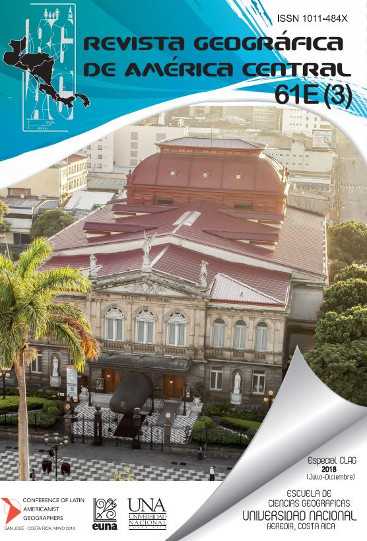Portuguese Origins of a 16th Century Aqueduct in México
DOI:
https://doi.org/10.15359/rgac.61-3.24Keywords:
Mexico, Madeira, landscapes, aqueducts, technology transfersAbstract
Many aqueducts built during the Spanish colonial era remain standing in México, albeit not functioning. A few date to the 16th century. Some of these early aqueducts are quite spectacular and highly visible. Others are small and are located in places not easily found. Despite their size, small aqueducts are important for understanding knowledge pertaining to technology transfers from the Old World to the New. One such aqueduct is on the property of the Hacienda de Pacho, near Xalapa in the state of Veracruz. One of its highly unusual characteristics is that its construction involved Gothic arches. No other colonial aqueduct in México has such features. According to documentary courses dating to AD 1591, it was built by the hacienda’s original owner who was from the Portuguese island of Madeira. This paper reports on field activities involved in verifying the Maderian origins of this unique aqueduct.
References
Cambrezy, L. & Lascuráin, B. (1992). Crónicas de in territorio fraccionado de la hacienda al ejido (Centro de Veracruz). México: Ediciones Larousse.
Chelmicki, J. C. C. de (2008). Memória sobre o Aqueducto Geral de Lisboa feita por ordem do Ministério das Obras Públicas em portaria de 15 de Fevereiro de 1856.
Lisboa, Portugal: EPAL—Empresa Portuguesa das Águas Livres.
Crespo, H. (1988). Historia del Azúcar en México. 2 vol. México: Fonda de Cultura,Económica, e Azúcar, S.A.
Gouveia, D. F. de (1985). O Açucar de Madeira: A Manufactura Açucareira Madeirense (1420-1500), En: Atlantico [Funchal] 4, 260-272.
Greenfield, S. (1977). Madeira and the Beginnings of New World Sugar Cane Cultivation and Plantation Slavery: A Study in Institutional Building. En: Annals of the New York Academy of Sciences 292(4), 536-552.
Håkansson, N. T. & Widgren, M., eds. (2014). Landesque Capital: The Historical Ecology of Enduring Landscape Modifications. Walnut Creek, USA: Left Coast Press.
Hillman Chapoy, I. (2007). La Hacienda de Nuestra Señora de los Remedios también conocida como Hacienda de Pacho. Unpublished manuscript on file at Hacienda de Pacho.
Patel, R., & Moore, J.W. (2017). A History of the World in Seven Cheap Things: A Guide to Capitalism, Nature, and the Future of the Planet. Los Angeles, USA: University of California Press.
Stevens-Acevedo, A. R. (2013). The Machines that Milled the Sugar-Canes: The Horizontal Double Roller Mills in the First Sugar Plantations of the Americas. Unpublished paper on File at the Dominican Studies Institute, City College of New York, USA.
Underwood, J. & P. (2005). Landscapes of Madeira: A Countryside Guide. London, UK: Sunflower Books.
Valdes, O. (1961). El Padre Tembleque. México: Biblioteca Enciclopidica del Estada de México.
Viera y Clavijo, J. de (1991). Historia de Canarias, Las Palmas de Gran Canaria, España: Viceconsejería de Cultura y Deportes, Gobierno de Canarias.
Vieira, A. (2004). “Sugar Islands: The Sugar Economy of Madeira and the Canaries, 1450- 1650,” Tropical Babylons: Sugar and the Making of the Atlantic World, 1450-1680, Chapel Hill, USA: The University of North Carolina Press (pp. 42-84).
Published
How to Cite
Issue
Section
License
Proposed policy for journals offering Open Access
Authors publishing their works in the Journal acknowledge and agree to the following terms:
a) Authors retain the copyrights to their works and guarantee the Journal the right to be the first to publish their works, under the Creative Commons License Attribution-NonCommercial-ShareAlike 4.0 International, CC BY-NC-SA 4.0 International (https://creativecommons.org/licenses/by-nc-sa/4.0/deed.es), which allows others to share works upon complying with the acknowledgment of authorship and mention of the Journal as the original publisher of the work.
b) Authors are permitted to separately establish additional agreements for the non-exclusive distribution of the official edition of the work published in the Journal (for example, authors may desire to place the work in an institutional repository or incorporate it into a book that is to published elsewhere) so long they acknowledgment to recognize the Journal as the original publisher. The aforementioned additional agreements must respect the terms of the non-profit character and sharing philosophy of the original license (CC BY-NC-SA 4.0 International, https://creativecommons.org/licenses/by-nc-sa/4.0/deed.es).
c) Authors are encouraged to archive the post-print or editor/PDF version in Open Access repositories.






 REVGEO is licensed under https://creativecommons.org/licenses/by-nc-sa/4.0/deed.es
REVGEO is licensed under https://creativecommons.org/licenses/by-nc-sa/4.0/deed.es
.svg_4.png)

_(1).png)
_(1)_(1)_(1)_1.png)
(2)(1)(1)(1).png)
